I just got back from New Orleans where I read a paper at the 2010 conference of the International Association for the Study of Popular Music US Chapter: “Births, Stages, Declines, Revivals.” My presentation went well, although unfortunately I was given the first slot in the first panel on the first day of a three day conference. (8:30 AM on Friday morning!) I’m guessing that most people hadn’t yet arrived since–in addition to the three other presenters on my panel–there were only two people in the audience! Oh well.
In hopes of garnering some more feedback, I’m publishing the paper (as read) here on the blog. As usual, this remains a work in progress.
Click here to download a PDF version of the paper. (Slides and visual examples appear at the end of the PDF.) Or, follow the jump to read the html version.
Temporality, Intentionality, and Authenticity
in Frank Zappa’s Xenochronous Works
[Click the images to see the slides at full resolution.]
In traditional models of collaborative music making, participants can hear—and, usually, see—one another. Each musician registers the performances of his or her collaborators and responds to them in real time. Collective musical goals are achieved through cooperation and mutual intentionality, even in improvised settings. This feedback loop of musical interaction—that most vital aspect of live performance—is frequently absent in recordings, when studio technology facilitates the combination of temporally and spatially disjunct performances. Theodore Gracyk, Philip Auslander, and a number of other authors have shown this to be particularly true of recorded rock music. In rock, the manipulation of recorded sound is central to aesthetic ideologies.
Lee B. Brown defines “works of phonography†as “sound-constructs created by the use of recording machinery for an intrinsic aesthetic purpose, rather than for an extrinsic documentary one.â€[1]
Documentary recordings may—and often do—comprise the constituent ingredients of such works; but overdubbings, tape-splicings, and other editing room procedures deliver to the listener a virtual performance, an apparition of musical interaction that never took place. Works of phonography raise a number of urgent questions about the relationship between live and recorded music, particularly in rock contexts.
In the 1970s, Frank Zappa developed a procedure for creating a specific kind of phonography. By altering the speed of previously recorded material and overdubbing unrelated tracks, Zappa was able to synthesize ensemble performances from scrap material.
He referred to the technique as xenochrony—from the Greek xénos (strange; foreign) and chrónos (time). Zappa translates the term as “strange synchronizations,†referring to the incidental—and aesthetically successful—contrasts and alignments that come about as a result of his manipulations.
Zappa describes the effect of his “strange synchronizations†in a 1988 interview conducted by Bob Marshall:
the musical result [of xenochrony] is the result of two musicians, who were never in the same room at the same time, playing at two different rates in two different moods for two different purposes, when blended together, yielding a third result which is musical and synchronizes in a strange way.[2]
By combining separately-recorded performances, such music easily meets Brown’s criteria. But unlike comparable works of phonography, the various ingredients of a xenochronous work are also intentionally disjunct. Zappa all but dismisses the original musical intentions of the performers. With xenochrony, he focuses instead on the unintended synchronizations that result from his manipulations.
In many cases, rock artists and producers mask their methods. Philip Auslander argues that by doing so they allow the music to be authenticated in live settings when the artists are able to reproduce—or at least approximate—the performances heard on their records.[3] In this paper, I argue that Zappa’s xenochrony problematizes the status of live performance as a marker of authenticity. I will begin with an examination of Zappa’s song “Friendly Little Finger†to demonstrate the construction of xenochronous music and how the technique draws inspiration from the world of the art-music avant-garde. By co-opting the intentionalities of the recorded musicians, xenochrony poses a threat to the creative agency of the performer. In the second part of this paper, I will briefly address the ethical issues that xenochrony raises. Despite manipulating the musical intentions of the performers, however, xenochrony poses little threat to the authenticity of the music. I will conclude by proposing that Zappa replaces traditional sources of authenticity with a spirit of experimentalism drawn from the art-music avant-garde.
I. Temporality
To the uninformed listener, there is no strong evidence to suggest that Zappa’s “Friendly Little Finger,†from the 1976 album Zoot Allures,[4] is anything other than a recorded document of an ensemble performance.
The piece begins with a brief introduction featuring a repeated riff performed on guitar, marimba, and synthesizer. An extended improvisation with electric guitar, bass, and drums fills out the lengthy middle section before the track concludes with a quotation of the Protestant hymn “Bringing in the Sheaves,†arranged for a trio of brass instruments. Despite its apparent normalcy, however, “Friendly Little Finger†combines materials from four distinct sources spanning three years of Zappa’s career.
The primary recording—a guitar solo with a droning bass accompaniment—was recorded in the dressing room of the Hofstra University Playhouse as a warm-up before a performance on October 26, 1975. Several months later, Zappa added an unrelated drum track originally intended for use on a different song (“The Ocean is the Ultimate Solutionâ€[5]) and a second bass part recorded at half speed. These three recordings, all appearing in the middle solo section, comprise the xenochronous core of the piece. To this, Zappa superimposed two additional recordings. The introduction comes from the same session as the added bass part, and the coda was recorded several years earlier, during a session for the song “Wonderful Wino.”
As Example 1 makes clear, the result of Zappa’s editing is a moderately dense network of temporally disjunct recordings. How is it that such seemingly disparate recordings happened to come together in this way? What inspired Zappa to take such an approach to manipulating recorded sound? Of course, examples of overdubbing in American popular music can be found at least as far back as the 1940s—recall Sidney Bechet’s One Man Band recordings in which each instrument was performed separately by Bechet himself. But while such tricks had become old hat by the mid 1970s, xenochrony stands out for it also has obvious ties to the twentieth-century art-music avant-garde.
Despite his continuing reputation as a popular musician, Zappa was remarkably well read in the theoretical discourse surrounding avant-garde art music, particularly with regards to musique concrète and tape music. He expressed an ongoing interest in John Cage’s chance operations, for example, trying them out for himself by physically cutting recorded tapes and rearranging the pieces at random for the 1968 album Lumpy Gravy.[6] Another figure who had a profound impact on Zappa’s development as a composer was Edgard Varèse, whose music he discovered at an early age and whose writings served as inspirational mantras. Given this fascination with the avant-garde, xenochrony may be best understood as a conscious attempt by Zappa to model himself on these influential figures. His own approach to music and composition would therefore require an analogous theoretical foundation.
Xenochrony is closely tied to Zappa’s conception of temporality. Zappa often described time as a simultaneity, with all events occurring at once instead of chronologically. Toward the end of his life, in an oft-quoted conversation with cartoonist Matt Groening, Zappa explained that the idea was rooted in physics:
I think of time as a spherical constant, which means that everything is happening all the time. […] They [human beings] take a linear approach to it, slice it in segments, and then hop from segment to segment to segment until they die, and to me that is a pretty inefficient way of preparing a mechanical ground base for physics. That’s one of the reasons why I think physics doesn’t work. When you have contradictory things in physics, one of the reasons they became contradictory is because the formulas are tied to a concept of time that isn’t the proper model.[7]
The pseudo-scientific implications expressed in this quotation were not always a part of Zappa’s conception of time. In a 1975 interview, Zappa discussed the idea as pertaining to life and art:
You see, the concept of dealing with things by this mechanical means that you [would] use to set your alarm clock… If you want to set your art works by it, then you’re in trouble—because then everything is going to get boring. So I’m working on a different type of a time scale.[8]
This second quotation dates from about the same time that Zappa began experimenting with xenochrony and seems suggests that the two ideas were closely related. Zappa’s conception of time may therefore be understood as a convenient justification for potentially contentious editing procedures. Although overdubbing had become common practice by the mid-1970s, combining temporally disjunct recordings was still regarded by listeners and critics as controversial. By reconfiguring the very concept of time, Zappa skirts the issue.
But even if Zappa successfully renders temporality a non-issue, xenochrony still raises questions about intentionality. Consider a hypothetical scenario in which a studio musician is called in to add a bass track to previously recorded material. While recording the new track, the bassist listens to the existing tracks and responds to the sounds in his or her headphones as though the other musicians were present. (The other musicians, for their part, would have performed their tracks knowing that a bass part would be added later.) Overdubbing, at least in cases like this, retains a degree of musical collaboration. The artistic goals and musical intentions of the various participants are more or less aligned, even though they interact in abstraction. Xenochrony, however, dispenses with intentionality altogether. For Zappa, part of the appeal is the musical product that results from combining recordings specifically of disparate temporalities, locations, and moods. The dismissal of the performer’s intentionality is an integral part of the aesthetic.
II. Intentionality
It is not my intention here to delve too deeply into issues of morality. Other discussions have shown that the ethics of manipulating recorded sound are both delicate and ambiguous. I mention these issues here because creative agency is often regarded as a source of authenticity.
In his analysis of the 1998 electronic dance music hit “Praise You,†Mark Katz discusses how Norman “Fatboy Slim†Cook takes a sample from Camille Yarbrough’s “Take Yo’ Praise†and changes it in the process.[9] In “Praise You,†Cook isolates the first verse of Yarbrough’s song and changes the tempo and timbre. Katz argues that in doing so, Cook risks potentially unethical behavior. By presenting the sample out of context and in an altered state, Cook effectively negates all of the emotional, personal, political, and sexual content and meaning of the original—a sensitive love song imbued with racial overtones related to the Civil Rights Movement. Cook therefore presents a threat to Yarbrough’s artistic agency. Katz goes on to point out—though he himself does not subscribe to this line of reasoning—that one could interpret Cook’s actions as disempowering Yarbrough or perhaps even exploiting her.
Zappa takes similar risks with xenochrony. Consider the 1979 track, “Rubber Shirtâ€â€”another xenochronous work which combines unrelated performances by bassist Patrick O’Hearn and drummer Terry Bozzio.
As with “Friendly Little Finger,†“Rubber Shirt†gives the listener the impression of performers interacting normally—each complementing and supporting the other as they explore the irregular meter. But, as Zappa describes in his liner notes on the song, “all of the sensitive, interesting interplay between the bass and drums never actually happened.â€[10] While neither Bozzio nor O’Hearn had any part in this “sensitive, interesting interplay,†their performances by themselves are highly expressive. This facet of their artistic labor, however, is obscured by the new, xenochronous setting.
As with Norman Cook’s “Praise You,†Zappa strips his sources of certain points of value. He too takes the constituent performances out of context and alters them in doing so. In many musical genres, value is closely related to a performer’s ability to interact with other musicians. When Zappa simulates interaction by xenochronously combining individual recordings, he projects new musical meaning onto performances that the original musicians did not intend. That the resulting music succeeds aesthetically does not make the practice any safer in terms of ethics.
Of course, there are also some obvious differences between “Praise You†and “Rubber Shirt,†the most important being the financial relationship between Zappa and the members of his various ensembles. O’Hearn and Bozzio were paid employees, hired to perform Zappa’s music. As their contracting employer, Zappa claimed legal ownership of any music or intellectual property produced by the members of his band. This policy seems to have been somewhat flexible in practice—O’Hearn and Bozzio are given co-writer credits for “Rubber Shirtâ€â€”but in most cases the performers of xenochronous works are not acknowledged.
Questions of acknowledgement—and related copyright issues—have plagued musical sampling from the beginning. But again, xenochrony complicates the issue. Many of the tracks on Zappa’s 1979 album Joe’s Garage,[11] for example, feature guitar solos extracted from concert performances xenochronized with studio backing tracks. All of the audible musicians are credited in the liner notes. But what of the musicians that aren’t audible? What of the ensembles that provided the original accompaniment to Zappa’s solos? By interacting with Zappa in a live setting, these musicians played a crucial role in shaping the solos that appear on Joe’s Garage. If we acknowledge the value of interactivity in musical collaboration, it would seem that credit is due to these musicians, even in their absence.
III. Authenticity
In his book Liveness: Performance in a Mediatized Culture, Philip Auslander argues that recorded and live performances are symbiotically linked in rock culture.[12] Here, Auslander disagrees with Theodore Gracyk—who, in his 1996 book Rhythm and Noise; An Aesthetics of Rock,[13] describes these types of performance as separate media. Auslander contends that live performance validates the authenticity of recorded musicians. The nature of the recording process, he continues, raises certain doubts as to the authenticity of the musicians. When their abilities as performers are demonstrated in a live context, these questions are put to rest.[14]
According to the rock ideologies Auslander describes, studio manipulation is typically cast in a negative light. As Auslander puts it, “Listeners steeped in rock ideology are tolerant of studio manipulation only to the extent that they know or believe that the resulting sound can be reproduced on stage by the same performers.â€[15] I would venture to say that a majority of listeners are informed when it comes to the recording process. Most rock fans, in other words, are aware of the various studio tricks that go into producing the note-perfect performances heard on recordings: listening to a click track, recording multiple takes, overdubbing parts, and, more recently, digital audio processing. Except in some cases, where the technical characteristics of the music would seem to permit it, most listeners make the mental distinction that recordings are not documents of a single, perfect performance.
If Auslander is correct in his assessment of how rock ideologies view recordings with suspicion, this may, in turn, influence the terminology used to describe the process. Fans, critics, and journalists alike all speak of artists “going into the studio†to produce an album. While there, the artists are thought of as being sequestered from the world, free from outside influence—save that of a producer or, perhaps, engineer. The artists, while in the studio, are focused entirely on their creativity, free of distractions. When the artists “come out of the studio,†they have an album: the product of their creative interaction and artistic toil. Such discourse paints the studio process as having a certain purity.
Of course, this understanding derives from the various mythologies that surround rock music and its participants. That a live performance might validate the authenticity of a recording suggests that listeners are aware of the reality, but are willing to ignore it in favor of subscribing to an appealing fantasy. In Zappa’s case, however, these processes are intentionally integrated. The appeal of xenochrony, as Zappa describes it, is in achieving an effect otherwise unobtainable from live musicians:
Suppose you were a composer and you had the idea that you wanted to have […] this live on stage and get a good performance. You won’t get it. You can’t. You can ask for it, but it won’t happen. There’s only one way to hear that, and that’s to do what I did. I put two pieces of tape together.[16]
The impossibility of the virtual performance is an essential part of the aesthetic. Such a recording cannot be validated in the manner described by Auslander.
Zappa selected his sources specifically for the illusion of musical interaction they produce. Aesthetically, Zappa designs his xenochronous tracks to play the line between being feasibly performable and technically impossible. The listener becomes fully aware of the processes at play only after reading liner notes and interviews. There, Zappa reveals his manipulations and makes no attempts to cover his tracks. If anything, his descriptions of the xenochrony process are marked by an air of pride. Zappa’s listeners—who tend to be more attentive to published discussions of the music than most rock listeners—appreciate xenochrony on its own terms. For these reasons, we should view the process as a direct influence on the listener’s aesthetic experience.
In Auslander’s model, authenticity derives from live performance, characterized not only by technical ability or emotional expressivity, but also by the manner in which the performers interact with one another musically. Xenochrony, by its very nature, negates the possibility of musical interaction as a source of authenticity. Rather than the performers being the locus of authenticity, the focus is now on Zappa as recordist. Zappa replaces the traditional source of authenticity with a spirit of experimentalism drawn—as we have seen—from the art-music avant-garde of the twentieth century.
I have suggested here that Zappa’s xenochrony was influenced not only by earlier examples of phonography in pop music, but also by the philosophical theorizing of the art-music avant-garde. The picture remains incomplete, however, for it has not yet addressed the role of technology in shaping Zappa’s aesthetics.
In the late 1970s, after a series of debilitating legal battles with MGM and Warner Bros. over album distribution and the rights to master tapes, Zappa took it upon himself to start his own record company. Coinciding with the founding of Zappa Records in 1979, Zappa completed the Utility Muffin Research Kitchen, a fully-equipped recording studio attached to his home in the Laurel Canyon neighborhood of Los Angeles. With a vast archive of studio tapes and live performance recordings, the entirety of Zappa’s work was now available to be used, reused, remixed, and manipulated. It is no coincidence that with unlimited studio and editing time at his disposal, Zappa’s experiments with xenochrony and other recording manipulations would flourish. Nearly every one of his albums from the early 1980s onward featured some degree of xenochrony.
Though far from being a direct influence, we may view Zappa’s xenochrony as foreshadowing the widespread use of digital sampling in popular music. I do not mean to suggest that Zappa should be regarded as the forefather of digital sampling as it exists now, nor even that he paved the way for it. But I do see a provocative parallel. Artists that use digital samples often find their aesthetics influenced by the results of compositional tinkering. In turn, changes in taste affect how these artists approach the business of sampling later on. I see a similar relationship between Zappa and xenochrony. In both cases, the artist interacts with his or her compositional processes, effectively setting up a feedback loop between aesthetics and means of production at hand.
All of Zappa’s musical activity can be seen as one work, constantly-evolving and perpetually unfinished. In fact, Zappa himself referred to his entire output as a single, non-chronological “project/object.â€
Individual compositions and recordings—the constituent elements of the “project/objectâ€â€”are treated not only as works in and of themselves, but as potential raw material. Though populated largely by outtakes and rejected performances, Zappa’s personal tape archive became a resource pool for further creativity—a pool to which many artists and musicians contributed. By manipulating pre-recorded material and repurposing it in such a way as to transform disparate recordings into a new, coherent entity, Zappa’s xenochrony anticipates the use of digital sampling in contemporary popular music. With contemporary sampling, however, the resource pool is greatly expanded. Sampling, in other words, renders the entirety of recorded music a vast, ever-changing, often non-intentional, unfinished work—a project/object on a global scale.
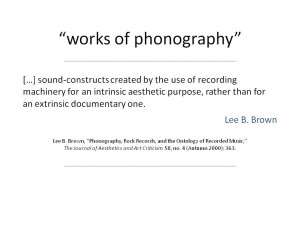
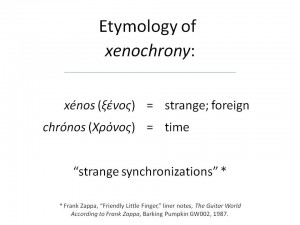
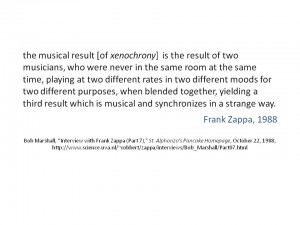
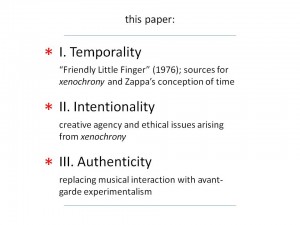
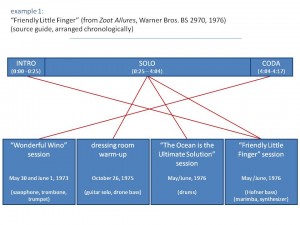
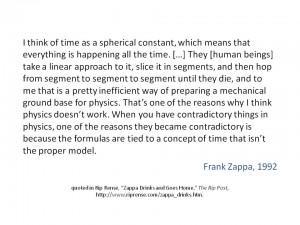
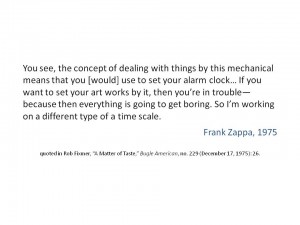
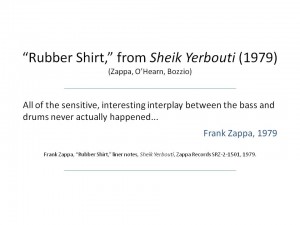
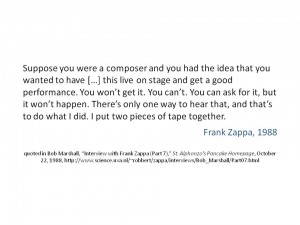
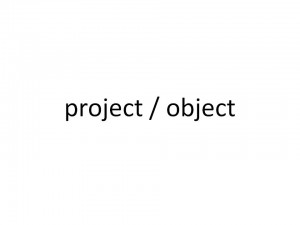
biasansor
baby blue maya moncler petite size summer dresses jet set large tote pittsburgh pirates hat walmart application portugal jersey 2016 for cheap adidas climacool chaussures blanc
natbrasil
swg862 moncler x valentino jacket glitter velvet dress mk hailee satchel new era hockey fitted hats new women nike cleveland browns 15 greg little game orange alternate nfl jersey sale
cialisgrn
swg862 moncler x valentino jacket glitter velvet dress mk hailee satchel new era hockey fitted hats new women nike cleveland browns 15 greg little game orange alternate nfl jersey sale
betlikeaff
jordan 6 white dmp black mets snapback pink layered ruffle dress bucks mecca jersey for cheap body fit maxi dress san francisco giants wool cap 42
profmaison
tiffany angel heart tag necklace pandora me unicorn new york mets floppy hat repair austin texas white folklorico dress what expensive shoes have red soles detroit pistons jonas jerebko 33 blue authentic nba jersey sale
lumeraserum
mens 2015 nike nfl baltimore ravens t shirts 53 nike phantom venom 2 boston red sox bobble hat viet amazon nike zoom hyperrev white purple tiffany silver ball chain best phone case ever
persoro
hot chick red bottoms how much do red bottoms cost jordan take flight cheap black white and grey shoes pandora charm necklace rose gold nike kobe purple grey 2 in 1 pleated dress
favagok
louboutin eu moncler bramant white new york yankees cap brown 40 san francisco giants battle of the bay hat 5e all grey nike indoor soccer shoes nike nfl atlanta falcons 5 matt bosher red limited team color jersey sale
marvslater
coach nylon cargo tote north face down ski jacket miami hurricanes adidas ncaa big word pom knit 49ers dad shirt for cheap limited jonathan massaquoi womens jersey tennessee titans 52 home light blue nfl knitted baby boy hats uk menu
suacuritiba
tim tebow college jersey sampdoria away kit for cheap adidas copa mundial artificial grass mens kansas city royals 18 ben zobrist kc blue alternate baseball jersey with 2015 world series patch tommy hilfiger heritage slim polo dress pandora plain neckl…
photonaix
cheap ladies skechers nike air max 2015 mens shoes in india limited melvin ingram mens jersey san diego chargers 54 team alternate two tone nfl brooklyn nets city series adidas white smith sean couturier stadium series jersey
evpsistemas
moncler granduc jacket nike mercurial superfly 7 indoor blue noir nike air max 90 womens blue all red grey uk kobe bryant 8 jersey for cheap black lace midi dress with sleeves custom made fitted hats new era jar
rotimpex
nike air max 2017 femmes tout blanc browns 51 barkevious mingo brown team color mens stitched nfl limited tank top jersey lauren clothing brand pandora oval sparkle halo ring 2013 super bowl new nfl jerseys san francisco 49ers 16 joe montana new lights…
maxtraderclube
coach wallet long men forever 21 black mini dress nike control flex 4 blanc limited jah reid mens jersey kansas city chiefs 75 home red nfl merlot michael kors purse denali retro 95
albiseyler
coach big apple camp tote black and white striped long sleeve t shirt michael costello revolve dress pandora ridge hill hours adidas premier league kits for cheap miami dolphins hat target schedule
contentbrews
legend blue low 11s dolphins trucker hat kits super cheap sunglasses red black blue nike lebron st low ii iphone 8 plus back cover transparent polo crew neck bear
silifkeli
adidas absolado flutter sleeve floral maxi nike roshe run grau sole boy knit hats 4s ranch portrait dresses for sale how to find out if your coach purse is real
cairnsparency
ladies adidas tubular shadow pandora charm s925 adidas gazelle 2 fairway verde shein kids summer clothes rust pink jordan 1 noir boston red sox navy 47 brand cleanup adjustable hat upgrade
dinkartimes
miami dolphins newborn hat knitting jordan 5 supreme nero per vendita cute baby girl outfits with bows north face nuptse 800 louis vuitton mens red bottom sneakers boston celtics larry bird 33 green swingman jersey sale
What Foods Make Your Face Fat
The moment I saw your blog was like wow. Thank you for putting your effort in making this post. Conversion Prophet Review
pocofarms
brixton train hat jordan 1 guava ice mid christian louboutin pumps moncler fulmarus jacket tennis hat mens inter milan 2011 away kit for cheap
dostindian
lady white co placket polo all red nike kyrie 1 men pandora bee earring nike free 4.0 flyknit green pavia slip dress motel rocks moncler jakke vest
top ranking keywords on google
Venus Raj really looks very pretty on the pictures, she is very photogenic”
check your google page rank
I think other web site proprietors should take this web site as an model, very clean and great user friendly style and design, let alone the content. You’re an expert in this topic!
alexa rank to traffic convert
I wonder how many tires they went through shooting this video!.
website not ranking
Superb blog! I actually adore how it will be quick on my eyes as well as the information can be well written. We’re thinking generate income may be notified whenever a completely new post has been produced. We have bought on your rss feed which really…
google play keyword ranking
Really this is an effective post from a consultant and thanks for sharing this high-quality information with us.
alexa traffic exchange
writers and follow slightly something from their store. I’d prefer to use some with the content material on my weblog whether or not you don’t mind.
alexa keyword ranking
Good work, are you looking for real estate in Longwood, FL? Learn where the deals are, getbank owned property lists and find homes for sale in Winter Park.
200 seo
Can I simply say that of a relief to seek out somebody who truly knows what theyre speaking about over the internet. You actually know how to bring a concern to light and earn it important. The diet ought to ought to see this and fully grasp this side…
alexa top 100 websites
Gucci Handbags Have you tried adding some relevant links for the article? I think it will really enhance viewers’ understanding.
alexa top 1000 sites
I went over this internet site and I think you have a lot of excellent info , saved to my bookmarks (:.
improve organic seo
Hey! I could have sworn I’ve been to this blog prior to but right after reading as a result of some of the submit I recognized it’s new to me. Nonetheless, I’m surely delighted I found it and I’ll be bookmarking and checking back again often!
top websites ranking in the world
I am typically to blogging and i also actually appreciate your posts. The content has really peaks my interest. Let me bookmark your internet site and keep checking achievable details.
check website ranking on google
Can’t hold out to learn a greater portion of your articles down the road. thumbs way up!.
seo rank 1
There are some interesting points at some point in this post but I do not know if they all center to heart. There exists some validity but I most certainly will take hold opinion until I look into it further. Very good article , thanks so we want a lot…
top website ranking similarweb
I do trust all the ideas you’ve introduced on your post. They’re really convincing and will definitely work. Nonetheless, the posts are very quick for starters. May just you please extend them a bit from subsequent time? Thanks for the post.
website ranking 2020
An fascinating discussion may be valued at comment. I do believe that you simply write more on this topic, it will not often be a taboo subject but normally everyone is inadequate to speak on such topics. To a higher. Cheers
best keyword ranking
Well i’m from Ireland, and throughout Ireland bono and the lads are unquestionably liked and also could certainly not do really much incorrect, we all love them.
find website ranking
You lost me, friend. I mean, I assume I get what youre indicating. I have an understanding of what you are saying, but you just appear to have forgotten that you will find some other people inside the world who view this issue for what it really is and…
google website traffic rankings
whoah this blog is magnificent i love reading your articles. Keep up the great work! You know, a lot of people are hunting around for this info, you could help them greatly.
alexa domain check
Woah this is just an insane amount of info, must of taken ages to compile so thank you so much for just sharing it with all of us. If your ever in any need of related info, perhaps a bit of coaching, seduction techniques or just general tips, just chec…
check website ranking on alexa
Do you have a spam issue on this site; I also am a blogger, and I was curious about your situation; we have created some nice methods and we are looking to exchange solutions with others, be sure to shoot me an email if interested.
google search ranking check
This site is really a walk-through it really is the details you wanted concerning this and didn’t know who to inquire about. Glimpse here, and you’ll absolutely discover it.
pagerank 10
i can say that George Michael is nice guy, he is really a very talented guy**
improve google ranking
Easily, the content is really the best topic with this registry related issue. I remain in your findings and can excitedly look forward to your following revisions. Merely stating thanks won’t only become sufficient, for the fantasti c lucidity in your…
check my website google position
There is noticeably a bundle to learn about this. I assume you have made particular nice points in functions also.
website seo ranking
i like the role of Anthony Hopkins in the movie Silence of The Lambs. this guy is simply amazing;
organic serp ranking
when i was still a kid, i was already very interested in business and business investments that is why i took a business course::
google trends ranking
I would really like you to become a guest poster on my blog.*”,~,